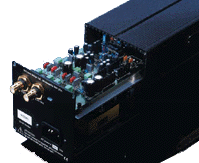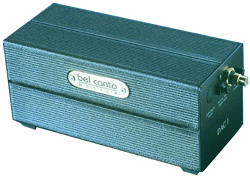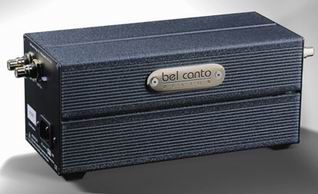Bel Canto Design DAC-1
| Bel Canto Design DAC-1 |
|
Upsampling D/A Converter |
|
Frank Alles |
|
2 October 2000 |
Input Sample Rates: 32 to 96kHz
Bit Depth: 16 to 24 Bit
Signal to Noise Ratio: >112 dB, A-weighted
Dynamic Range: 112 dB
Total Harmonic Distortion: <0.003%
Frequency Response: 0 to 48kHz –3 dB
Output Impedance: 50 ohms
Output Level: 2 Vrms
Input Options: 1 Toslink optical; 1 SPDIF coaxial RCA-type
Dimensions: 3.6″H × 3.6″W × 9″D
Weight: 4 lb.
Price: $1,295. USD
Warranty: Lifetime for first owner, 10 years for subsequent owners.
Manufacturer
Bel Canto Design
212 Third Avenue North, Suite 345
Minneapolis, MN 55401
Phone: 612/317-4550
Fax: 612/359-9358
Email: Info@BelCantoDesign.com
Web: www.belcantodesign.com
“There are other upsampling DACs currently available around the price of the Bel Canto DAC-1. In truth, I haven’t heard them in my system—but I have heard the DAC-1, and it will remain in my system as my benchmark…”
Bel Canto Design is one of those small cutting-edge companies that has consistently received praise and kudos in the audio press for providing musically involving products at reasonable prices. I have used the Bel Canto SEP-1 tube line stage preamp in the past and was very taken not only by its excellent sonic presentation, but by its modern styling and features.
The Bel Canto DAC-1 is not a piece of gear that you’d buy for its aesthetic appeal or features. Save for the gold embossed Bel Canto nameplate, it is your basic black box, small enough to fit inconspicuously behind other gear. The point of the piece is to elicit a level of sonic performance from CDs, by using the latest technology, which was virtually unattainable until recently. Bel Canto has focused on reducing errors in four areas: 1) Timing jitter in the DAC clock, 2) Quantization noise in the digital to analog conversion process, 3) Time domain smearing and, 4) Sources of electromagnetic interference. I have no way of making scientific measurements in these areas, but I think that the results of Bel Canto’s efforts can be ascertained by the most sensitive of instruments—the human ear.
As I said, the features of the DAC-1 are scant. On the front panel, two inputs are provided, 1 Toslink optical, and 1 SPDIF coaxial RCA-type, there is also a push button to invert polarity—a feature that I often use. One set of gold-plated RCA analog output jacks is located on the rear panel along with an IEC connector, for use with audiophile AC cords (or even the stock cord provided). That’s it—your basic “plug & play” device.
In my experience with the DAC-1, I discovered (early on) that the unit’s performance can vary dramatically with changes in transports or isolation bases and feet. Such changes resulted in shifts in tonal balance—which affected the perceived character of the sonic portrait. Please know that this phenomenon is not unique to the Bel Canto DAC, similar changes occurred with other DACs I’ve tried—so this would appear to be the rule—not the exception.

Initially, I used the DAC-1 in combination with my Parasound (C.E.C.) C/BD-2000 belt-drive transport and was rewarded with a splendid analog-like presentation, with a rich vibrant character, sharp clear transients, and a level of “air” and ambience around instruments that I had not previously witnessed with a CD source. I was quite pleased.
With a little prodding from Bel Canto’s Chad Baures, I bought a DVD player to use as a transport (Pioneer 626D) and hooked it up via a $35.00 optical Toslink cable by Monster Cable. With expectations high, I put on a track from Santana’s Supernatural (Arista 07822-19080-2) but was somewhat let down by the more brittle and clinical presentation that resulted. Switching to my Harmonic Technology (HT) coaxial digital cable (that I had used with the Parasound) reduced the brittleness somewhat, and I have to admit that the soundstage was very dimensional. The dynamics were great and the bass was “killer” too, but still I felt that the presentation with the Parasound transport was smoother and more analog-like, especially through the midrange. By contrast, the DVD transport sounded dryer and slightly coarser.

Cure For the Digital Blues!
One of the first CDs I played was The Specials’ The Singles Collection(Chrysalis F2 521823), not because it’s a great-sounding CD, but because it tends to sound a bit harsh (like a poor recording) when played on other equipment. I was quite surprised by the DAC-1’s ease in presenting a rich, harmonically coherent portrait. The brasses sounded natural, with just the right amount of bite and the vocals seemed more fleshed out and less edgy than what I remembered from previous listening. The soundstage had more depth, the bass was fuller, and the organ sounded exceedingly authentic—alive, in its own holographic capsule. “This is great,” I said to myself, “Let’s see how it sounds with other material.”
Listening to US 3’s “Dark Side,” from hand on the torch (Blue Note CDP 0777 7 80883 2 5), I was intrigued when I heard some low level electronic effects in the background that had gone unnoticed in earlier listening sessions. The high frequencies seemed delicate and focused, and they lacked any edginess or hardness, which can be the bane of lesser DACs. Indeed, Ray Brown’s “The Real Blues,” fromSummerwind (Concord Jazz CCD-4426), was rife with air and dimensionality from the filigreed brushwork of Jeff Hamilton. It was a sweet treat for the ears.
What’s more, the zydeco washboard on Queen Ida’s “My Tu Tu” fromCaught In The Act (GNP GNPD 2181), was clear and precisely defined with surgical precision—sans scalpel. And on cut 5, “Cotton-Eyed Joe,” the Bel Canto had no trouble mastering Peter Allen’s furious fiddle strokin’–which was mighty close to my recollection of the live instrument’s sound.
Whipping out my favorite Stravinsky CD recording, L’ Histoire du Soldat (Everest EVC 9049), I observed the striking clarity of the trumpets and the poignancy of the cello on “The Devil’s Triumphal March”. Copious air around the pounding drums at the close of the piece punctuated the DAC-1’s considerable ability to evoke the dramatic flair of the composition. Playing track 11, “Moderato” fromThe Ebony Concerto, on the same CD, I was simply enchanted by the dynamic lifelike presentation. The horns, drums, and acoustic guitar and harp were truly magnificent. Even at multiples of the DAC-1’s price, I find it difficult to believe that it could sound much better.
To this point, I haven’t said very much about the bass performance of the DAC-1, but the truth, is that I found its reproduction of the lower octaves to be both ample and articulate. It seemed to capture just the right balance of weight to agility, edging my Parasound D/AC-2000 in terms of ultimate extension and power. Electric bass was bouncy and easy to follow, drums sounded natural and I had a better sense of hearing the character of drum skins on various recordings. The bass of the DAC-1 was quite up to the task.
And the Winner Is…
We audiophiles are actually the big winners here, in that we can reap the sonic rewards of more advanced technology at an affordable, reasonable price. To my ears the DAC-1 offered a rightness of tone, along with greater inner detailing and certainly more air and ambient information than I have heard from any of the “old-school” DACs. It purveyed an enhanced sense of dynamic shadings and quite frankly sounded very close to the performance of my hefty analogue turntable system—at a much lower total cost and minus the ticks and pops.
There are other upsampling DACs currently available around the price of the Bel Canto DAC-1. In truth, I haven’t heard them in my system—but I have heard the DAC-1, and it will remain in my system as my benchmark, until I hear concrete proof that a better sounding piece exists in the same price range. Highly recommended.
![]()
Don’t forget to bookmark us! (CTRL-SHFT-D)
Stereo Times Masthead
Publisher/Founder
Clement Perry
Editor
Dave Thomas
Senior Editors
Frank Alles, Mike Girardi, Russell Lichter, Terry London, Moreno Mitchell, Paul Szabady, Bill Wells, Mike Wright, and Stephen Yan,
Current Contributors
David Abramson, Tim Barrall, Dave Allison, Ron Cook, Lewis Dardick, John Hoffman, Dan Secula, Don Shaulis, Greg Simmons, Eric Teh, Greg Voth, Richard Willie, Ed Van Winkle, Rob Dockery, Richard Doron, and Daveed Turek
Site Management Clement Perry
Ad Designer: Martin Perry


 Specifications
Specifications

Be the first to comment on: Bel Canto Design DAC-1